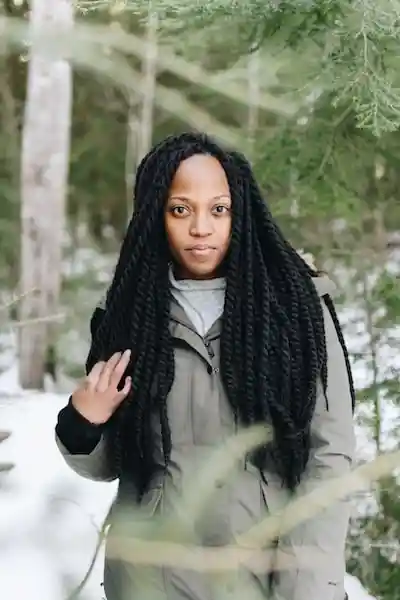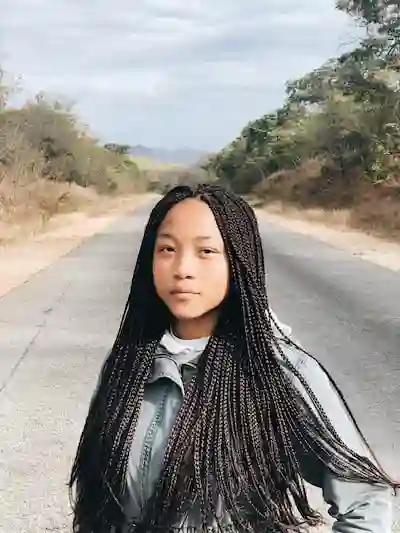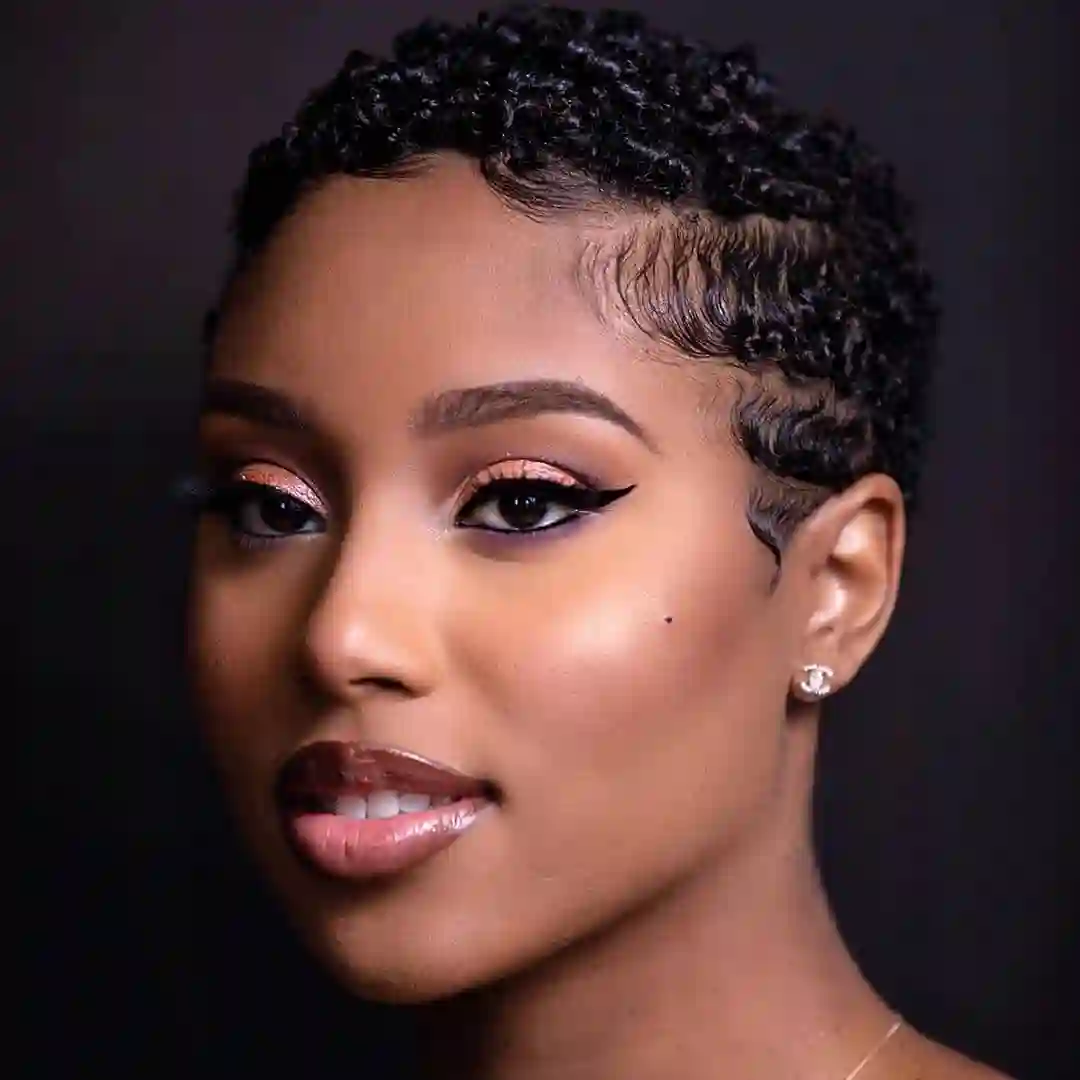Tree Braids are a popular protective style with many extensions. Many Hairstyles are made using different techniques.
Whether you want to add volume or length or experiment with different textures, tree braids can be the perfect solution.
This braided look involves cornrowing small sections of hair close to the scalp while adding loose extensions.
The result is a natural-looking style that protects natural hair while allowing for creativity.
Tree Braid Installation Process
The tree braid installation process involves several steps to achieve a stylish and protective hairstyle.
Here is an overview of the typical process:
- Preparation: Begin by washing and conditioning the natural hair to ensure it is clean and moisturized before the installation process. Detangle the hair gently to remove any knots or tangles.
- Cornrowing: Section the hair into neat, small to medium-sized cornrows following a specific pattern or design based on the desired look. The cornrows serve as the foundation for attaching the extensions.
- Adding Extensions: Start by selecting high-quality extensions that match the texture and color of the natural hair for a seamless blend. Attach the extensions to the cornrows using a braiding technique that involves incorporating the natural hair with the extension hair.
- Braiding Process: Begin braiding the extensions into the cornrows, starting from the roots and working towards the ends. Ensure that each braid is secure and even throughout the process to maintain a consistent look.
- Finishing Touches: Trim any excess extension hair at the ends of the braids to achieve a uniform length. Seal the ends of the braids using a preferred method such as dipping in hot water or applying a sealant to prevent unraveling.
- Styling: Once all the braids are completed, style the tree braids according to personal preference. This may involve parting the braids in a specific pattern, adding accessories, or incorporating different braid sizes for a customized look.
- Maintenance: After installation, it is essential to care for the tree braids properly to maintain their appearance and protect the natural hair underneath. Regular moisturizing, scalp care, and gentle handling are key aspects of maintaining tree braids.
What are Tree Braids?
Tree braids are a form of hair extension created by tightly braiding small sections, or trees,” of hair close to the scalp.
This method provides a secure grip and an even weight distribution for the extensions.
Tree braids can add length and fullness to hair, allowing for various styling options, from updos to ponytails.
With proper care, tree braids can last for months, making them a practical choice for those seeking protection and style.

Types of Tree Braids:
- Tree Braids with Human Hair: Achieve a natural look and feel with human hair extensions, which can be styled and maintained just like your own hair.
- Curly Tree Braids: Embrace curls and waves for a more textured and playful appearance.
- Tree Micro Braids: For a finer, more intricate look, opt for micro-sized braids that create a delicate and elegant style.
- Tree Braid Updo Hairstyles: Elevate your look for special occasions with stunning updo styles that showcase the beauty of tree braids.
Benefits of Tree Braids
- Hair Growth Promotion: Tree braids can stimulate hair growth by safeguarding the ends and preventing damage.
- Low-Maintenance: Once installed, tree braids require minimal upkeep compared to other styles, eliminating the need for frequent re-braiding.
- Seasonal Versatility: Suitable for both hot and cold seasons, tree braids offer a practical and stylish choice year-round.
- Universally Appealing: Tree braids can be tailored to individual preferences regardless of hair type or texture.
- Extended Lifespan: With proper care, tree braids can last several weeks, making them a long-lasting choice.
Maintenance for Tree Braids
Maintaining tree braids ensures they look their best. Here are some tips for upkeep:
- Gentle Daily Brushing: Use a soft-bristled brush to prevent matting and tangling.
- Regular Washing: Shampoo and condition your hair every 7–10 days using mild, sulfate-free products.
- Moisturize Frequently: Apply a light oil or serum to keep hair hydrated, preventing frizz and flyaways.
- Protect at Night: Tie your hair with a satin scarf or a silk pillowcase to minimize friction damage.
Cost of Tree Braids
The cost of tree braids can vary depending on factors such as hair length, thickness, and the number of braids desired.
Generally, tree braids range between $100 and $300. Prices may fluctuate based on location and stylist.
Tree Braids for Natural Hair
Tree braids are a popular choice for individuals with natural hair looking to add length, volume, and versatility to their hairstyles.
They offer a protective styling option that allows natural hair to rest and grow without daily manipulation.
Tree braids can be customized to match the texture and color of natural hair, seamlessly blending in for a natural look.
This styling technique provides a way to experiment with different looks while maintaining the health and integrity of natural hair.
Tree Braids Vs Crochet Braids
Tree braids and crochet braids are both popular hairstyling techniques that involve adding extensions to natural hair.
While tree braids involve individual cornrows with extensions that are left loose at the ends, crochet braids use a crochet needle to loop extensions through cornrows.
Tree braids offer a more natural look with versatile styling options, while crochet braids are known for their quick installation and affordability.
The choice between tree braids and crochet braids often depends on individual preferences for style, maintenance, and desired outcomes.
Tree Braids with Human Hair
Using human hair for tree braids offers a more natural look and feel compared to synthetic hair extensions.
Human hair provides versatility in styling, allowing for various heat styling options and blending seamlessly with natural hair.
It also tends to be more durable and long-lasting, making it a preferred choice for individuals looking for a high-quality and realistic finish with their tree braid hairstyles.
Tree Braid Styles for Long Hair
Tree braid styles offer a wide range of options for individuals with long hair looking to experiment with different looks.
From intricate designs with small and tight tree braids to loose and flowing styles with larger braids, there are endless possibilities for styling long hair with tree braids.
Adding accessories such as beads, cuffs, or ribbons can enhance the overall look and create unique and personalized styles.
Whether opting for sleek and elegant tree braid styles or bold and creative designs, individuals with long hair can explore diverse options to showcase their personal style.
Are Tree Braids Good for Your Hair?
Tree braids can be beneficial for your hair when done properly. They offer protection and minimize manipulation, reducing the risk of breakage and promoting hair growth.
However, ensuring they are tight is crucial, as maintaining proper scalp care and avoiding leaving them in for extended periods to prevent potential damage.
Professional installation and regular maintenance are key to reaping the benefits of tree braids while keeping your hair healthy.
What is the Difference between Tree Braids and Crochet Braids?
Both are popular braids, but also they are different in some conditions
Attachment Method
Tree braids involve braiding your natural hair and then attaching extensions to the braids. The extensions are added in small sections, creating a seamless look.
Crochet braids use a different technique. They involve cornrowing your natural hair and then attaching pre-braided or pre-twisted extensions to the cornrows using a crochet hook.
Installation Time
Tree braids typically take longer to install because the extensions are added strand by strand.
Crochet braids are quicker to install because the extensions are already pre-braided or pre-twisted and attached in larger sections.
Versatility
Tree braids offer more versatility regarding the texture and length of the extensions because they can be customized to your preference.
Crochet braids are limited to the texture and style of the pre-made extensions you choose.
Maintenance
Tree braids may require more maintenance due to the individual attachment method, including occasional re-tightening and moisturizing.
Crochet braids are relatively low-maintenance, with minimal daily care required.
Tension
Tree Braids: If installed too tightly, tree braids can cause scalp tension and discomfort. Crochet Braids: Crochet braids, when installed correctly, generally have less tension on the scalp.
Duration
Tree braids tend to last longer, sometimes up to 2-3 months, depending on care and maintenance.
Crochet braids typically have a shorter lifespan, around 4-6 weeks, before they need to be redone.
Tree Braid Styles:
There are many tree braid styles, ranging from straight hair to curly and wavy options.
You can also experiment with different hair lengths and textures to suit your unique preferences and personality.
How Tree Braids Are Created
The tree braid technique begins with parting clean, detangled hair into small sections. Starting near the root, the stylist will tightly cornrow small strands of natural hair.
They incorporate loose pieces of extension hair as they braid, leaving some strands outside the braid.
This creates the distinctive “tree” effect as the braid progresses downward.
When the braid reaches the desired length, it is secured.
This process is repeated all over the head to complete the look. A light moisturizer can be applied to seal the style.
Style Versatility
Once installed, tree braids offer endless options for styling. Wear them long and straight or curled into loose waves.
Try half-up styles like buns or ponytails. For special occasions, transform them into gorgeous updos.
You can also play with color by selecting vibrant braids in shades like red, blue,, or lavender.
Low Maintenance Caring
Caring for tree braids is straightforward. Gently cleanse the scalp weekly to prevent buildup.
Between washes, spritz on a nourishing spray to keep hair moisturized. Be gentle when brushing to prevent breakage.
Protect your style at night with a satin bonnet or scarf. With basic TLC, tree braids can last 4-6 weeks before needing a refresh.
Ideal for All Hair Types
Whether your texture is fine, oily, or in between, tree braids suit various hair qualities and densities.
The braiding technique distributes tension evenly along the strand to prevent damage.
Their versatility in color and length options makes finding a great look easy. Tree braids allow expression through ever-changing updo possibilities, too.
Protect Your Style and Expression
Tree braids offer a low-maintenance protective option that allows hair to retain length and strength over time.
Plus, they provide endless ways to showcase personal style through creativity with color, length, and styling.
Tree braids could be a top choice for safely retaining hair growth while enjoying endless looks.
Getting Your Tree Braids Installed
While it’s possible to install tree braids, seeing a professional stylist for the best results is usually recommended.
Look for someone experienced in doing cornrows and braiding extensions. Be prepared for the installation to take 3-6 hours, depending on your desired fullness and length.
It’s a good idea to start with clean, detangled hair to smooth the braiding process. You can ask the stylist beforehand about their preference for natural hair products.
Come prepared to sit for an extended period while they work section by section.
Caring for Your Braids
In between weekly washes, keep braids looking fresh with these tips:
- Spritz with a lightweight moisturizer daily to prevent dryness. Gently work the product along the braids.
- When sleeping, cover with a satin scarf or bonnet to avoid friction and breakage.
- Avoid vigorous activities that could cause the braids to become wet with sweat, as this can lead to mildew growth and odor.
- Use a light oil like jojoba or coconut to massage your scalp through the cornrows 1-2 times weekly.
- Be very gentle when brushing with a boar bristle brush to prevent tangles.
- Secure styles like half-up dos with soft hair ties or clips that won’t pull on the braids.
With proper care, tree braids can generally last 4-6 weeks before needing to be re-done or taken down.
Taking good care of your scalp and braids during this time will keep them looking freshly installed for longer.
Best Human Hair for Tree Braids
The best human hair for tree braids is typically virgin or Remy human hair. These options offer high quality, natural look, and reduced tangling.
Choose a texture and length that matches your style, opt for reputable brands, ensure ethical sourcing, and be prepared to invest in maintenance for longevity.
Color matching and budget considerations are also important factors in your choice. Consulting with a professional stylist for personalized recommendations is advised.
How To Do Tree Braids for Beginners?
How Long Do Tree Braids Last?
The longevity of tree braids largely depends on factors such as hair type, maintenance, and the quality of the installation.
On average, tree braids can last anywhere from 4 to 8 weeks with proper care and maintenance.

Choosing the Best Hair for Tree Braids:
Selecting the right hair extensions is crucial for achieving the desired look and durability.
Human hair provides a natural appearance and allows for various styling options, making it a popular choice for tree braids.
Tree Braids with Tea Tree Oil:
Some individuals incorporate tea tree oil into their tree braid care routine.
Tea tree oil has antimicrobial properties that help maintain a healthy scalp and prevent itching and flaking.
What Kind Of Hair Do You Use For Tree Braids?
Human hair extensions offer a wide range of options in terms of length, texture, and color, catering to individual preferences.
Synthetic hair extensions, however, provide a more consistent appearance when incorporated into tree braids.
However, they may have different durability than human hair due to their delicate nature.
Some individuals use their hair for tree braids, a fantastic option for those with thick, sufficiently long hair.
Regardless of the type of hair extensions you choose, it is crucial to ensure they are of high quality and that the stylist applies them to safeguard the health of your natural hair.
Conclusion
Tree braids are a fantastic way to express your style, protect your natural hair, and experiment with different looks.
Whether you opt for tree braids with human hair, curly tree braids, or any other style mentioned in this guide, you’re sure to turn heads with your stunning new hairstyle.
So, embrace the beauty of tree braids and unlock endless possibilities for your hair.
Frequently Asked Questions.
Can tree braids get wet?
Yes, tree braids can get wet, but avoiding overly frequent exposure to water is essential as it can potentially loosen the braids.
When washing or wetting your tree braids, use a gentle shampoo and conditioner, followed by a thorough rinsing to keep the braids in good condition.
What is another name for tree braids?
Tree braids are also commonly referred to as Invisible braids.
This alternate name stems from the fact that the braiding technique used for tree braids makes the extensions seem to grow directly from the scalp, thereby rendering the braids practically invisible.
What kind of hair do you use for tree braids?
You can use either synthetic or natural human hair for tree braids. The choice of hair type largely depends on personal preference.
Synthetic hair is usually more affordable and offers a variety of color and texture options.

Anuli is a Hair Styles Expert & the founder of wiselybraids.com, a website dedicated to providing the latest tips, trends, and Articles for hairstyling with Braids. With years of experience in the industry, Anuli has become a go-to source for hair care advice and inspiration.
